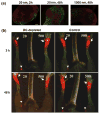In Vivo Modulation of Dendritic Cells by Engineered Materials: Towards New Cancer Vaccines
- PMID: 22125572
- PMCID: PMC3224090
- DOI: 10.1016/j.nantod.2011.08.005
In Vivo Modulation of Dendritic Cells by Engineered Materials: Towards New Cancer Vaccines
Abstract
Therapeutic cancer vaccines are emerging as novel and potent approaches to treat cancer. These vaccines enhance the body's immune response to cancerous cells, and dendritic cells (DCs), an initiator of adaptive immunity, are a key cell type targeted by these strategies. Current DC-based cancer vaccines are based on ex vivo manipulation of the cells following their isolation from the patient, followed by reintroduction to the patient, but this approach has many limitations in practical cancer treatment. However, recent progress in materials science has allowed the design and fabrication of physically and chemically functionalized materials platforms that can specifically target DCs in the body. These materials, through their in vivo modulation of DCs, have tremendous potentials as new cancer therapies. Nanoparticles, which are several orders of magnitude smaller than DCs, can efficiently deliver antigen and danger signals to these cells through passive or active targeting. Three-dimensional biomaterials, with sizes several orders of magnitude larger than DCs, create microenvironments that allow the effective recruitment and programming of these cells, and can be used as local depots of nanoparticles targeting resident DCs. Both material strategies have shown potential in promoting antigen-specific T cell responses of magnitudes relevant to treating cancer.
Figures











Similar articles
-
Outer membrane vesicles engineered to express membrane-bound antigen program dendritic cells for cross-presentation to CD8+ T cells.Acta Biomater. 2019 Jun;91:248-257. doi: 10.1016/j.actbio.2019.04.033. Epub 2019 Apr 17. Acta Biomater. 2019. PMID: 31003032
-
Engineered exosomes as an in situ DC-primed vaccine to boost antitumor immunity in breast cancer.Mol Cancer. 2022 Feb 11;21(1):45. doi: 10.1186/s12943-022-01515-x. Mol Cancer. 2022. PMID: 35148751 Free PMC article.
-
Dendritic cells in the host response to implanted materials.Semin Immunol. 2017 Feb;29:33-40. doi: 10.1016/j.smim.2017.04.002. Epub 2017 May 7. Semin Immunol. 2017. PMID: 28487131 Free PMC article. Review.
-
Therapeutic Liposomal Vaccines for Dendritic Cell Activation or Tolerance.Front Immunol. 2021 May 13;12:674048. doi: 10.3389/fimmu.2021.674048. eCollection 2021. Front Immunol. 2021. PMID: 34054859 Free PMC article. Review.
-
Ex vivo dendritic cell generation-A critical comparison of current approaches.Int Rev Cell Mol Biol. 2019;349:251-307. doi: 10.1016/bs.ircmb.2019.10.003. Epub 2019 Nov 15. Int Rev Cell Mol Biol. 2019. PMID: 31759433 Review.
Cited by
-
Cancer-Associated Fibroblasts: Accomplices in the Tumor Immune Evasion.Cancers (Basel). 2020 Oct 14;12(10):2969. doi: 10.3390/cancers12102969. Cancers (Basel). 2020. PMID: 33066357 Free PMC article. Review.
-
Enhanced anti-tumor immunotherapy by silica-coated magnetic nanoparticles conjugated with ovalbumin.Int J Nanomedicine. 2019 Oct 16;14:8235-8249. doi: 10.2147/IJN.S194352. eCollection 2019. Int J Nanomedicine. 2019. PMID: 31802864 Free PMC article.
-
Developing immune-regulatory materials using immobilized monosaccharides with immune-instructive properties.Mater Today Bio. 2020 Sep 30;8:100080. doi: 10.1016/j.mtbio.2020.100080. eCollection 2020 Sep. Mater Today Bio. 2020. PMID: 33205040 Free PMC article.
-
Self-assembled peptide nanofibers raising durable antibody responses against a malaria epitope.Biomaterials. 2012 Sep;33(27):6476-84. doi: 10.1016/j.biomaterials.2012.05.041. Epub 2012 Jun 12. Biomaterials. 2012. PMID: 22695068 Free PMC article.
-
An Update on Mesoporous Silica Nanoparticle Applications in Nanomedicine.Pharmaceutics. 2021 Jul 12;13(7):1067. doi: 10.3390/pharmaceutics13071067. Pharmaceutics. 2021. PMID: 34371758 Free PMC article. Review.
References
Grants and funding
LinkOut - more resources
Full Text Sources
Other Literature Sources
